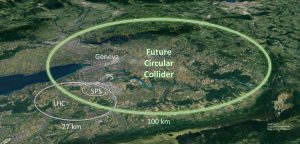CERN published concept design of a future 100 km collider FCC
CERN (European Organisation for Nuclear Research) has published a study of the proposed Future Circular Collider (FCC), which should in the future replace the existing Large Hadron Collider (LHC). The study presents various possibilities for its realization, importance for physics and describes the technical challenges, costs and schedule for realisation thereof.
Over the next two years, the particle physics community will be updating the European Strategy for Particle Physics, outlining the future of the discipline beyond the horizon of the Large Hadron Collider (LHC). The possibility of a future circular collider will be examined during the strategy process, together with the other post-LHC collider option at CERN, the CLIC linear collider.
The discovery of the Higgs boson at the LHC opened a new path for research, as the Higgs boson could open the door into new physics. Detailed studies of its properties are therefore a priority for any future high-energy physics accelerator. Different options explored by the FCC study offer also unique opportunities of physics beyond the Standard Model, which is important to account for observations such as dark matter and the domination of matter over antimatter and to make significant progress in our understanding of the universe.
 The FCC is presented in several options. The FCC’s ultimate goal is to provide a 100 km superconducting proton accelerator ring, with an energy of up to 100 TeV, meaning an order of magnitude more powerful than the LHC. The FCC timeline foresees starting with an electron-positron machine (just as LEP preceded the LHC), a powerful “Higgs factory”.
The FCC is presented in several options. The FCC’s ultimate goal is to provide a 100 km superconducting proton accelerator ring, with an energy of up to 100 TeV, meaning an order of magnitude more powerful than the LHC. The FCC timeline foresees starting with an electron-positron machine (just as LEP preceded the LHC), a powerful “Higgs factory”.
The costs of a large circular electron-positron collider would be in the 9 billion EUR range, including 5 billion EUR for the civil engineering work for a 100 km tunnel. The physics programme could start by 2040 at the end of the High-Luminosity LHC operations. The costs estimate for a superconducting proton machine is around 15 billion EUR. This machine could start operation in the late 2050s.